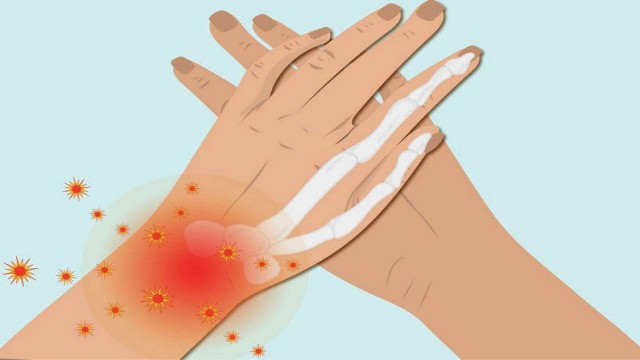How to relieve rheumatoid arthritis pain?

"Rheumatoid arthritis is a disease that erodes and destroys the joints of the human body and is incurable. Today, let's talk about this "immortal cancer"!
What is rheumatoid arthritis?
The doctor explained: "Rheumatoid arthritis is a relatively common disease, and most patients are young adults. It is a systemic chronic disease with mainly joint lesions, starting with synovial lesions, then involving tendons, ligaments and other connective tissues, and finally destroying joint cartilage and bone tissue, leading to joint ankylosis. In addition, other organs or tissues such as skin, subcutaneous tissue, muscles, blood vessels, nerves, pleura, pericardium, lymph nodes, spleen and bone marrow can also be involved.
Its etiology has not yet been completely clarified, but it is mostly thought to be related to infection and systemic immune disorders, and some scholars believe that the occurrence of the disease may also be related to endocrine imbalance."
What are the clinical manifestations of rheumatoid arthritis?
The onset of rheumatoid arthritis varies from 16 to 55 years of age and is more common in women than in men, with insidious onset, often with general discomfort, loss of appetite, weight loss, sweating and joint pain, and other premonitory symptoms, mostly symmetrical polyarthritis, most often affecting the small joints of the extremities, especially the metacarpophalangeal and proximal interphalangeal joints of the hands. The finger joints are stiff when waking up in the morning and cannot make a tight fist.
In the early stages of rheumatoid arthritis, there is pain and stiffness, followed by gradual swelling, fluid accumulation and local temperature increase, significant local pressure pain and muscle spasm, followed by muscle atrophy and muscle contracture. In the late stage, due to the destruction of articular cartilage, ligament and tendon relaxation, and muscle imbalance, various deformities of the joint may occur, the most common being subluxation of the metacarpophalangeal joint and ulnar deviation of the fingers, and finally, joint ankylosis. Rheumatoid arthritis is characterized by spontaneous remission and recurrent attacks, and joint symptoms can last for months to decades, with most patients losing some joint function.
Extra-articular manifestations of rheumatoid arthritis often include subcutaneous nodules, skin rashes, heart disease, and eye disease. Laboratory tests often include elevated white blood cell counts, secondary anemia, increased sedimentation, and positive rheumatoid factor tests. x-rays show varying degrees of atrophy and osteoporosis of the bones throughout the body.
How can rheumatoid arthritis patients perform functional exercises?
Rheumatoid arthritis is a systemic disease with synovial inflammation as the main manifestation. Functional exercise is an adjunct to rheumatoid arthritis treatment, which can relieve symptoms and improve prognosis. How can rheumatoid arthritis patients perform functional exercises in daily life? Zhang Chunyan, a specialist at Peking Union Medical College Hospital, gives these tips!
There are 8 main methods of functional exercise as follows.
1. Finger joints: alternate between making a fist and flattening the fingers, and flatten the palm and fingers against the table when flattening.
2. Wrist joint: both hands together, repeatedly flexing to both sides with force.
3. Elbow joint: Repeatedly practice elbow flexion and extension movements.
4. Shoulder joint: shake your hand and touch your left shoulder with your right hand from front to back, alternating between left and right hands.
5. Neck joint: repeatedly do forward flexion and backward extension of the neck and left and right rotation movements.
6. Ankle joint: Repeatedly do ankle flexion, dorsiflexion, inversion-extension and left-right gyration movements, with each activity being done to the maximum.
7. Knee joint: knee flexion exercise in prone position, repeatedly doing forceful flexion and extension exercises of the lower leg, alternating between the two lower limbs.
8. Hip joint: hold the knee flexion exercise.
Each of the above joint exercises once a day in the morning, midday and evening, 5 to 30 times each time. Exercise principle is 2 hours after the activity of physical recovery, step by step, persistent. In addition, there are other daily methods to move the joints, such as swimming, knitting, playing chess, playing Rubik's cube, touching the height, stretching, kicking, etc. In short, early and regular functional exercises for each joint can effectively improve the patient's symptoms and improve the patient's quality of life.
Tips for rheumatoid arthritis patients to reduce joint damage
Rheumatoid arthritis has a high rate of disability and deformity, so in addition to receiving regular treatment, are there any other ways to help protect our joints and reduce the risk of disability and deformity? The rheumatologists at Ping An Hospital give the following advice.
1. When joints are inflamed, they become unstable and more susceptible to injury. When using force, tiny joints such as finger joints are more prone to deformation. Therefore, in daily life, patients should try to use the larger and stronger joints, when carrying heavy objects, try not to use the fingers, use the arm and elbow joints; do not use the fingers for support, should use the palm of the hand to support.
2. Do not stand for a long time, and sit down to rest at appropriate times. When you sit down, you should often change your sitting position, change the position of your feet, stretch the muscles and bones of your lower limbs, or get up and walk around. Should avoid prolonged finger flexion, such as writing, typing should stop from time to time to rest and stretch the fingers.
3. Whether in sleep, walking or sitting, to maintain good posture. When unscrewing the cap of a bottle, do not just use your fingers to unscrew, you should use your palm with pressure to unscrew. When sitting down, do not overflex your knees and keep your feet flat on the ground.
4. If you feel joint pain when moving, stop the activity immediately and check whether the activity method is improper.



